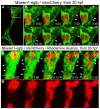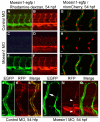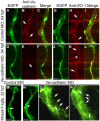Moesin1 and Ve-cadherin are required in endothelial cells during in vivo tubulogenesis
- PMID: 20736288
- PMCID: PMC2926960
- DOI: 10.1242/dev.048785
Moesin1 and Ve-cadherin are required in endothelial cells during in vivo tubulogenesis
Abstract
Endothelial tubulogenesis is a crucial step in the formation of functional blood vessels during angiogenesis and vasculogenesis. Here, we use in vivo imaging of living zebrafish embryos expressing fluorescent fusion proteins of beta-Actin, alpha-Catenin, and the ERM family member Moesin1 (Moesin a), to define a novel cord hollowing process that occurs during the initial stages of tubulogenesis in intersegmental vessels (ISVs) in the embryo. We show that the primary lumen elongates along cell junctions between at least two endothelial cells during embryonic angiogenesis. Moesin1-EGFP is enriched around structures that resemble intracellular vacuoles, which fuse with the luminal membrane during expansion of the primary lumen. Analysis of silent heart mutant embryos shows that initial lumen formation in the ISVs is not dependent on blood flow; however, stabilization of a newly formed lumen is dependent upon blood flow. Zebrafish moesin1 knockdown and cell transplantation experiments demonstrate that Moesin1 is required in the endothelial cells of the ISVs for in vivo lumen formation. Our analyses suggest that Moesin1 contributes to the maintenance of apical/basal cell polarity of the ISVs as defined by adherens junctions. Knockdown of the adherens junction protein Ve-cadherin disrupts formation of the apical membrane and lumen in a cell-autonomous manner. We suggest that Ve-cadherin and Moesin1 function to establish and maintain apical/basal polarity during multicellular lumen formation in the ISVs.
Figures








Similar articles
-
CMTM3 (CKLF-Like Marvel Transmembrane Domain 3) Mediates Angiogenesis by Regulating Cell Surface Availability of VE-Cadherin in Endothelial Adherens Junctions.Arterioscler Thromb Vasc Biol. 2017 Jun;37(6):1098-1114. doi: 10.1161/ATVBAHA.116.308792. Epub 2017 Apr 20. Arterioscler Thromb Vasc Biol. 2017. PMID: 28428220
-
Expression of VE-cadherin in zebrafish embryos: a new tool to evaluate vascular development.Dev Dyn. 2004 Sep;231(1):204-13. doi: 10.1002/dvdy.20102. Dev Dyn. 2004. PMID: 15305301
-
Distinct and redundant functions of Esama and VE-cadherin during vascular morphogenesis.Development. 2017 Apr 15;144(8):1554-1565. doi: 10.1242/dev.140038. Epub 2017 Mar 6. Development. 2017. PMID: 28264837
-
VE-cadherin and endothelial adherens junctions: active guardians of vascular integrity.Dev Cell. 2013 Sep 16;26(5):441-54. doi: 10.1016/j.devcel.2013.08.020. Dev Cell. 2013. PMID: 24044891 Review.
-
Dynamic Regulation of Vascular Permeability by Vascular Endothelial Cadherin-Mediated Endothelial Cell-Cell Junctions.J Nippon Med Sch. 2017;84(4):148-159. doi: 10.1272/jnms.84.148. J Nippon Med Sch. 2017. PMID: 28978894 Review.
Cited by
-
Endothelial Cell Dynamics in Vascular Development: Insights From Live-Imaging in Zebrafish.Front Physiol. 2020 Jul 22;11:842. doi: 10.3389/fphys.2020.00842. eCollection 2020. Front Physiol. 2020. PMID: 32792978 Free PMC article. Review.
-
Extracellular fluid viscosity enhances cell migration and cancer dissemination.Nature. 2022 Nov;611(7935):365-373. doi: 10.1038/s41586-022-05394-6. Epub 2022 Nov 2. Nature. 2022. PMID: 36323783 Free PMC article.
-
Tubulogenesis during blood vessel formation.Semin Cell Dev Biol. 2011 Dec;22(9):993-1004. doi: 10.1016/j.semcdb.2011.05.001. Epub 2011 May 20. Semin Cell Dev Biol. 2011. PMID: 21624487 Free PMC article. Review.
-
Protocol for whole-mount preparation, clearing, and visualization of the adult zebrafish spinal cord structures.STAR Protoc. 2024 Dec 20;5(4):103491. doi: 10.1016/j.xpro.2024.103491. Epub 2024 Dec 9. STAR Protoc. 2024. PMID: 39656590 Free PMC article.
-
Neural progenitor-derived Apelin controls tip cell behavior and vascular patterning.Sci Adv. 2024 Jul 5;10(27):eadk1174. doi: 10.1126/sciadv.adk1174. Epub 2024 Jul 5. Sci Adv. 2024. PMID: 38968355 Free PMC article.
References
-
- Bagnat M., Cheung I. D., Mostov K. E., Stainier D. Y. (2007). Genetic control of single lumen formation in the zebrafish gut. Nat. Cell Biol. 9, 954-960 - PubMed
-
- Bayless K. J., Davis G. E. (2002). The Cdc42 and Rac1 GTPases are required for capillary lumen formation in three-dimensional extracellular matrices. J. Cell Sci. 115, 1123-1136 - PubMed
-
- Bayless K. J., Davis G. E. (2004). Microtubule depolymerization rapidly collapses capillary tube networks in vitro and angiogenic vessels in vivo through the small GTPase Rho. J. Biol. Chem. 279, 11686-11695 - PubMed
-
- Berryman M., Franck Z., Bretscher A. (1993). Ezrin is concentrated in the apical microvilli of a wide variety of epithelial cells whereas moesin is found primarily in endothelial cells. J. Cell Sci. 105, 1025-1043 - PubMed
Publication types
MeSH terms
Substances
Grants and funding
LinkOut - more resources
Full Text Sources
Other Literature Sources
Molecular Biology Databases
Research Materials

